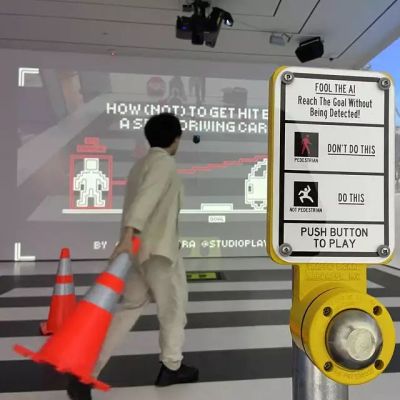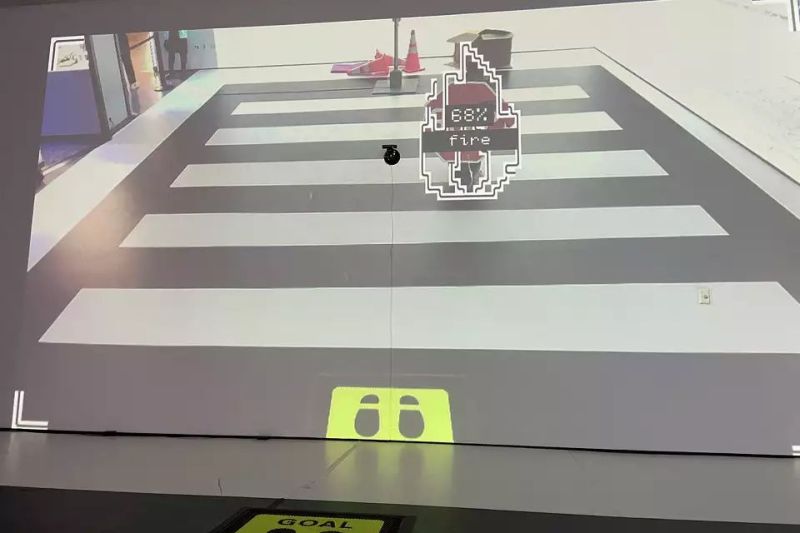In the discussions about how dangerous self-driving cars are – or aren’t – one thing is sorely missing, and that is an interactive game in which you do your best to not be recognized as a pedestrian and subsequently get run over. Even if this is a somewhat questionable take, there’s something to be said for the interactive display over at the Asian Art Museum in San Francisco which has you try to escape the tyranny of machine-vision and get recognized as a crab, traffic cone, or something else that’s not pedestrian-shaped.

The display ran from March 21st to March 23rd, with [Stephen Council] of SFGate having a swing at the challenge. As can be seen in the above image, he managed to get labelled as ‘fire’ during one attempt while hiding behind a stop sign as he walked the crossing. Other methods include crawling and (ab)using a traffic cone.
Created by [Tomo Kihara] and [Daniel Coppen], it’s intended to be a ‘playful, engaging game installation’. Both creators make it clear that self-driving vehicles which use LIDAR and other advanced detection methods are much harder to fool, but given how many Teslas are on the road using camera-based systems, it’s still worth demonstrating the shortcomings of the technology.
There’s no shortage of debate about whether or not autonomous vehicles are ready to share the roads with human drivers, especially when they exhibit unusual behavior. We’ve already seen protesters attempt to confuse self-driving systems with methods that aren’t far removed from what [Kihara] and [Coppen] have demonstrated here, and it seems likely such antics will only become more common with time.

















I’m already busy designing an
Intelligent Traffic Conethat uses Ai to cause mischief for autonomous vehicles and other street fairing Ai devices. Most of the time it will be stationary on the side of the pavement, but when the moment is right, it raises up it’s cone shaped shell and scuttles off to a strategic location on small robot dog like legs. Once in the desired location, the shell is lowered again and it just looks like a normal traffic cone again. Great idea eh?Autonomous traffic cone, I love it!
A herd of these autonomous cones could be used to divert all autonomous cars out of the city into the desert.
This reminds me of the Monty Python bit – `vicious gangs of keep left signs`
Do we need these in real live
https://www.youtube.com/watch?v=-SuJGxq_pcM
YES ….. That sketch shows that the Autonomous Traffic Cone (ATC) is not such a stupid idea.
Maybe just make an infinite loop of road diversion signs. Set up a number plate recognition camera to count how many you see more than once.
I think Monty Python already did this?
https://www.youtube.com/watch?v=-SuJGxq_pcM&t
Have to be cheap. Under $10…Plus a borrowed cone.
I’d ditch the robot legs.
KISS
Use a 1 cm bottom clearance and a very cheap chinesium RC car chassis, maybe tracked. Has to be CHEAP.
Make them have swarm behaviors. Slowly travel in ‘lines’. Diagonally over anything with lines painted. A RP nano w radio should do for brains. Don’t go where others in the swarm have tipped over. Slow travel planning is fine. Cheap low rez camera module. Don’t even try to plan far ahead.
Have the swarm scatter/flee when one is picked up.
Stop dead for an hour when honked at.
Lunge in front of cyclists, perhaps add ‘spoke stick’ (or fish).
Once in while, do a marching up and down the square or dance thing. Just at random.
One in 100: pulsejet, fuel and compressed air to start same.
I’m liking this idea more and more.
What cities are the major parties conventions this cycle?
That would be a huge rush. Prototype, then project it up and find swarm of volunteer builders. Schedule is undoable.
Still worth doing.
Where do we ‘expropriate’ the batteries? Lime scooters? Something obnoxious.
No way to recharge at that price point. Did any cities actually do the wireless bus charging spot at the stops?
Yes we’ll do a MP realization. Gladly. A few should include a ‘slapping fish’ for city workers. Rotting fish pops out and cone spins. Paint ‘Ministry of Silly Walks for official use only’ on side.
Yes, the SFgate link will take you to an article, but it only has a 30 second video surrounded by ads.
But, the following link takes you to the co-artist’s page with the video you really want to watch:
https://studioplayfool.com/how-not-to
It all started with that Kraftwerk album. Then came VLC the most useful media player, now it’s personal street defense. Safety Cones.
Wear vantablack, appear as a puddle, get run over.
Paint a tunnel on a wall, Wile E. Coyote style.
self driving vehicles are probably already safer than humans, bit it irrelevant due to the liability problem.
If I crash a car driving, I pay for it. If the software crashes the car, the software maker pays… Not a supportable business model..
Any well designed automation is safer than people doing the same thing, because as long as it isn’t broken, it will never deviate from the programming and always does the right thing within the limits of the program. The caveat is the programming, which for self-driving vehicles isn’t flexible enough or complex enough to account for the real world.
A Tesla can drive safer than people on a fenced-off highway, in dry weather, in daytime. Throw in anything mildly confusing and unusual, and it’s a whole different game. We have plenty of examples of that.
The Tesla will usually be okay on the fenced-off dry daytime highway, or at least better than the average mix of aggressive and/or incompetent drivers. But if that’s the only time you engage the computer, it could better be driven by a non-AI computer which centrally controls all the cars, as was envisioned in various old science fiction stories. The way modern AI cars get confused and do weird things shows it’s not necessary to deviate from your programming to cause problems, just to have programming that is inherently incompatible with human expectations.
At least when there’s humans driving badly even if they are breaking the rules, it’s easier to figure out what they are likely to do and to adapt. EG when someone pulled up beside me in the oncoming lane at a stop sign, I knew they were under the misconception that the road we were on was one-way, and I knew that I would be safest by leaving quickly and hoping they figured it out before anything bad happened.
“self driving vehicles are probably already safer than humans” citation needed.